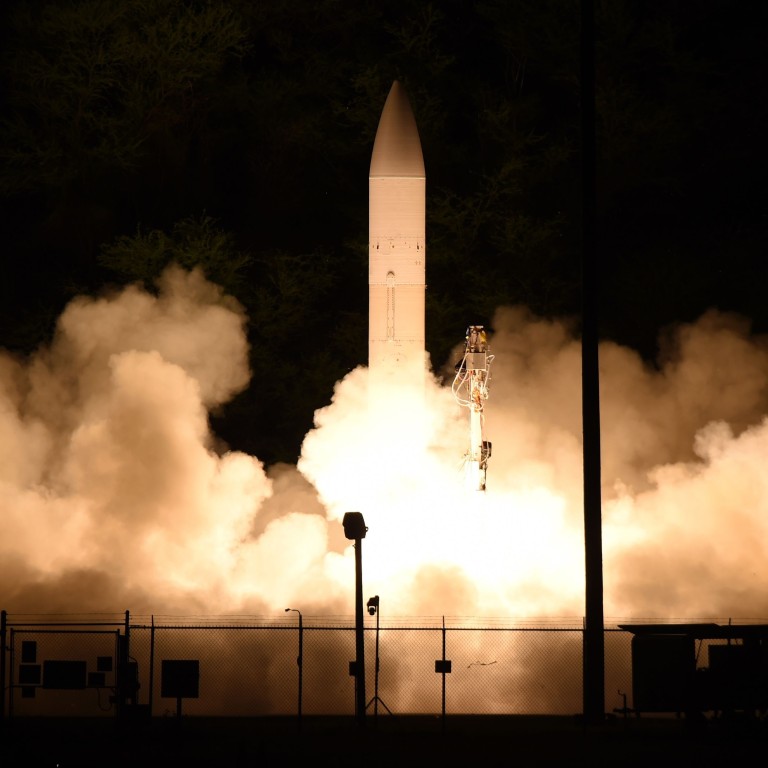
US successfully tests hypersonic missile in bid to catch up with China and Russia
- Such weapons travel much faster than current ones, can switch direction in flight and are unpredictable, making them much harder to track and intercept
- Moscow claimed to have operable hypersonic weapon in December, while Beijing has displayed its DF-17 hypersonic glide vehicle
The United States announced Friday it has successfully tested an unarmed prototype of a hypersonic missile, a nuclear-capable weapon that could accelerate the arms race between superpowers.
The Pentagon said a test glide vehicle flew at hypersonic speeds – more than five times the speed of sound, or Mach 5 – to a designated impact point.
The test followed the first joint US Army and Navy flight experiment in October 2017, when the prototype missile demonstrated it could glide in the direction of a target at hypersonic speed.
“Today we validated our design and are now ready to move to the next phase towards fielding a hypersonic strike capability,” Vice-Admiral Johnny Wolfe said in a statement.

Hypersonic weapons can take missile warfare, particularly nuclear warfare, to a new – and, for many, frightening – level.
They can travel much faster than current nuclear-capable ballistic and cruise missiles at low altitudes, can switch direction in flight and do not follow a predictable arc like conventional missiles, making them much harder to track and intercept.
Even as conventionally armed, non-nuclear weapons, they are viewed by analysts as raising the danger of conflict, because an adversary might not know how they are armed when launched.
Avangard: Russia’s nuclear-capable hypersonic missile enters combat duty
The Pentagon is pressing to catch up with rivals Moscow and Beijing in the race to develop hypersonics, even as it recognises they could dangerously raise the risks of a nuclear conflict, as countries struggle to build defences against them.
In its fiscal 2021 budget the US Defence Department requested US$3.2 billion for hypersonic programmes, up from US$2.6 billion in the current year. The goal is a deployable hypersonic capability by 2023, though that could be difficult.
“Delivering hypersonic weapons is one of the department’s highest technical research and engineering priorities,” the Pentagon said.
The joint Army-Navy test was carried out on March 19 from the Pacific Missile Range facility in Kauai, Hawaii. The test was for the military’s common-hypersonic glide body, or C-HGB weapon, designed to be launched from a rocket that could be land-, air- or sea-based.
“The glide body tested today is now ready for transition to Army and Navy weapon system development efforts,” said Mike White, the assistant director of the hypersonics programme.
In December, Russia declared it had placed into service its first Avangard hypersonic missile, making it the first country to claim an operable hypersonic weapon.
Russian officials claimed that in tests it had reached speeds of up to Mach 27, roughly 33,000km/h (20,500mph).
China is also investing significantly in their development. Last October it displayed its DF-17 hypersonic glide vehicle in its national day military parade.

The US military is meanwhile pouring money into advanced missile defence research to find ways to protect against hypersonics.
A senior Nato official warned that in a hypersonic missile strike, it may not even be clear what the target is “until there’s a boom on the ground”.
US defence firms doubling down on hypersonic weapons technology
“There is increasing investment in and deployment of hypersonic weapons that will severely limit response times available to targeted nations and create a dangerous degree of ambiguity and uncertainty,” it said.
“This uncertainty could lead to rapid escalation of military conflicts. At a minimum, these weapons are highly destabilising and presage a new arms race.”
Purchase the China AI Report 2020 brought to you by SCMP Research and enjoy a 20% discount (original price US$400). This 60-page all new intelligence report gives you first-hand insights and analysis into the latest industry developments and intelligence about China AI. Get exclusive access to our webinars for continuous learning, and interact with China AI executives in live Q&A. Offer valid until 31 March 2020.

.png?itok=arIb17P0)